Full inverse Compton Scattering: Total transfer of energy and momentum from electrons to photons
IF 1.5
3区 物理与天体物理
Q3 INSTRUMENTS & INSTRUMENTATION
Nuclear Instruments & Methods in Physics Research Section A-accelerators Spectrometers Detectors and Associated Equipment
Pub Date : 2024-10-11
DOI:10.1016/j.nima.2024.169964
引用次数: 0
Abstract
In this article we discuss a peculiar regime of Compton Scattering that assures the maximum transfer of energy and momentum from free electrons propagating in vacuum to the scattered photons. We name this regime Full Inverse Compton Scattering (FICS) because it is characterized by the maximum and full energy loss of the electrons in collision with photons: up to 100% of the electron kinetic energy is indeed transferred to the photon. In the case of relativistic electrons, characterized by a large Lorentz factor (), FICS regime corresponds to an incident photon energy equal to , i.e. approximately 255.5 keV. We interpret such an astonishing result as FICS being the time reversal of direct Compton Scattering of very energetic photons (of energy much greater than ) onto atomic electrons. Although the cross section of Compton scattering is decreasing with the energy of the incident photon, making the process less probable with respect to other reactions (pair production, nuclear reactions, etc.) when high energetic photons are bombarding a target, the kinematics straightforwardly implies that the back-scattered photons would have an energy reaching asymptotically . FICS is instead the unique suitable working point in Compton scattering for achieving the total transfer of (kinetic) energy exactly from the electron to the photon. Experiencing transitions from the initial momentum to zero in the laboratory system, in FICS the electron is also subject to very large negative acceleration; this fact can lead to possible experiments of sensing the Unruh temperature and related photon bath. On the other side of the energy dynamic range, low relativistic electrons can be completely stopped by moderate energy photons (tens of keV), leading to full exchange of temperature between electron clouds and photon baths. Cosmic gamma ray sources can be affected in their evolution by this peculiar FICS regime of Compton scattering.
完全反康普顿散射:能量和动量从电子到光子的全部转移
在这篇文章中,我们讨论了康普顿散射的一种特殊机制,它能确保在真空中传播的自由电子向散射光子最大程度地转移能量和动量。我们将这一机制命名为 "全反康普顿散射(FICS)",因为它的特点是电子在与光子碰撞时最大程度地损失了全部能量:电子动能的100%都转移到了光子上。相对论电子的特点是洛伦兹因子较大(γ≫1),在这种情况下,FICS 机制对应的入射光子能量等于 mec22,即大约 255.5 千伏。我们将这一惊人的结果解释为 FICS 是高能光子(能量远大于 mec2)对原子电子的直接康普顿散射的时间逆转。虽然康普顿散射的截面随着入射光子能量的增加而减小,因此当高能光子轰击目标时,这个过程相对于其他反应(成对产生、核反应等)来说不太可能发生,但运动学直接暗示,反向散射光子的能量将近似达到 mec22。相反,FICS 是康普顿散射中唯一合适的工作点,可以实现从电子到光子的(动能)完全转移。在实验室系统中,电子经历了从初始动量到零的跃迁,在 FICS 中,电子还受到非常大的负加速度;这一事实可能导致感测 Unruh 温度和相关光子浴的实验。在能量动态范围的另一侧,低相对论电子可以完全被中等能量的光子(几十千伏)阻止,从而导致电子云和光子浴之间的温度完全交换。宇宙伽马射线源在其演化过程中可能会受到康普顿散射这种奇特的 FICS 机制的影响。
本文章由计算机程序翻译,如有差异,请以英文原文为准。
求助全文
约1分钟内获得全文
求助全文
来源期刊
CiteScore
3.20
自引率
21.40%
发文量
787
审稿时长
1 months
期刊介绍:
Section A of Nuclear Instruments and Methods in Physics Research publishes papers on design, manufacturing and performance of scientific instruments with an emphasis on large scale facilities. This includes the development of particle accelerators, ion sources, beam transport systems and target arrangements as well as the use of secondary phenomena such as synchrotron radiation and free electron lasers. It also includes all types of instrumentation for the detection and spectrometry of radiations from high energy processes and nuclear decays, as well as instrumentation for experiments at nuclear reactors. Specialized electronics for nuclear and other types of spectrometry as well as computerization of measurements and control systems in this area also find their place in the A section.
Theoretical as well as experimental papers are accepted.

 求助内容:
求助内容: 应助结果提醒方式:
应助结果提醒方式:


